At FMS 2022, Samsung had what it called its PB SSD. The new SSD is not actually a petabyte, but the idea is that the new design can easily scale up to multi-petabyte racks. This is also a PCIe Gen5 NVMe SSD with a host of new technologies onboard.
Samsung PB SSD at 128TB for 60PB All-flash Racks
In the Samsung booth, the PB SSD was shown as a QLC drive. The form factor shown was an E3.S SSD that we covered in our E1 and E3 EDSFF to Take Over from M.2 and 2.5 in SSDs guide.
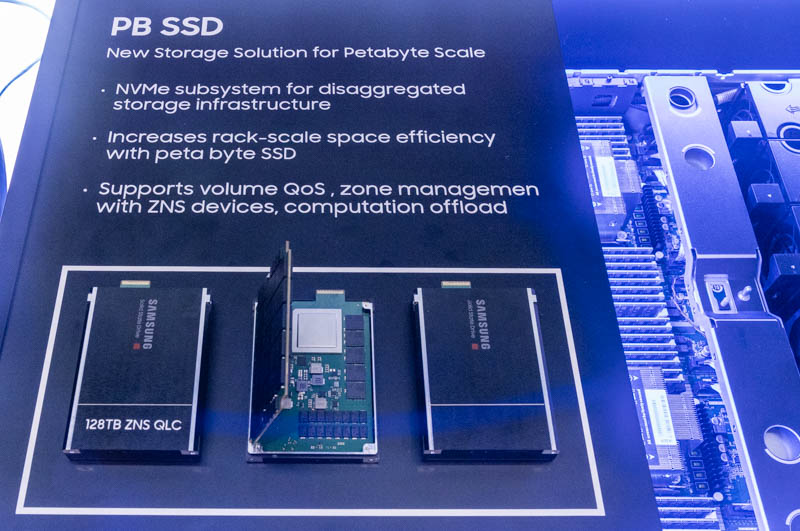
One can see the massive controller onboard and ample memory. Samsung also says this is a ZNS or Zoned Namespaces SSD. ZNS is important here because it allows a few things. One is better multi-tenancy. The other, and perhaps more important, is that ZNS allows for better alignment of data being written, thereby allowing much lower write amplification. This feature allows SSDs to expose more flash for storage rather than reserving capacity for spare area. While the capacity is higher, the ZNS SSDs do need to use this feature to achieve higher capacities.
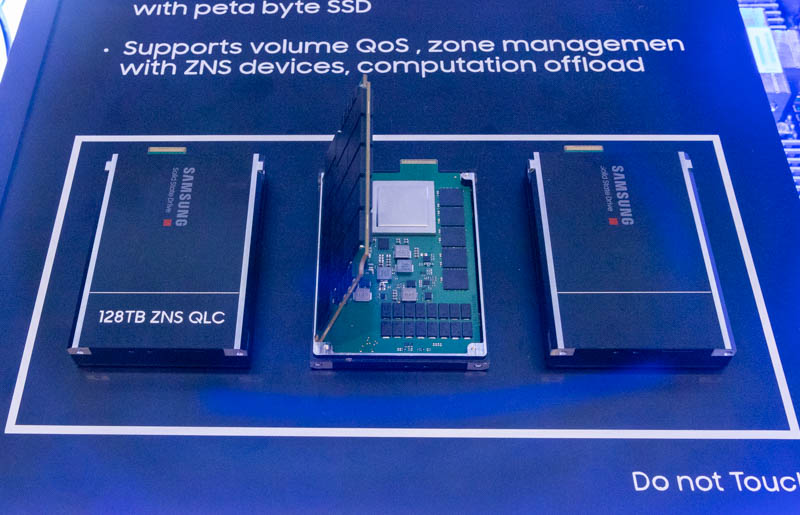
Samsung says that using these 128TB NVMe EDSFF E3 SSDs allows for lower space and energy requirements than traditional hard drives for both sequential and random read workloads. These larger SSDs would also allow for 60PB of storage in a rack.
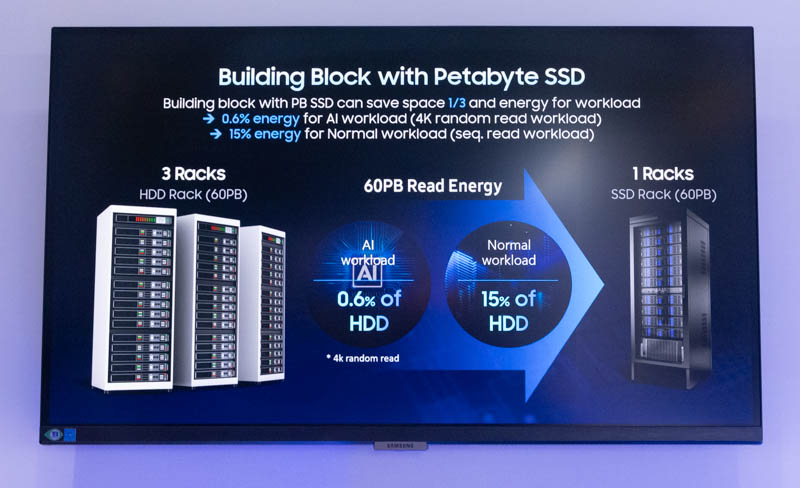
The Samsung PB ZNS SSD has a board packed with both sides of QLC NAND, then another board for the E3 connector, controller, DRAM, and more. We were not allowed to touch this “do not touch” floor demo.
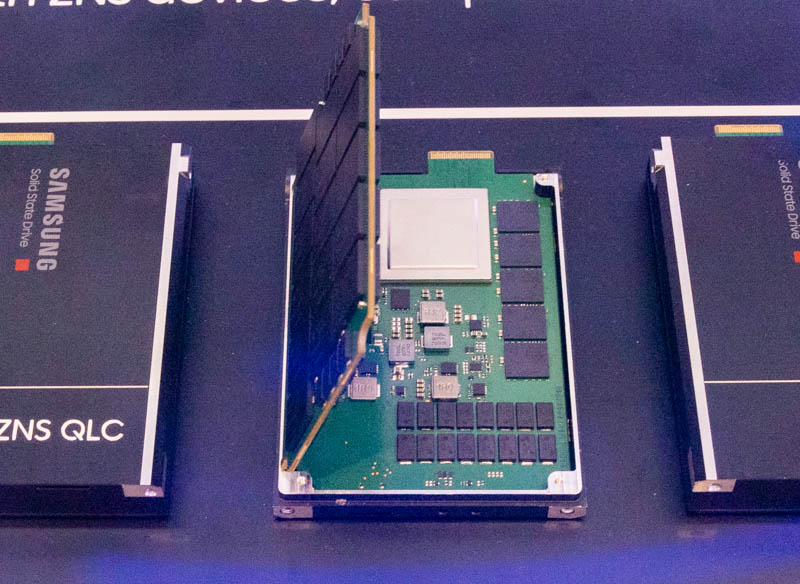
What was also interesting is that below the demo was a server we had not seen before. Samsung had not just the Intel Sapphire Rapids Eagle Stream DDR5/ PCIe Gen5/ CXL development platforms on the floor open to the public, but this demo also used an Inspur M7 server open to the public filled with Samsung’s DDR5 DRAM. Samsung did not say exactly what the Inspur platform it was showing is. We previously reviewed the Inspur Systems NF5280M5 and Inspur NF5280M6, so it is not too hard to figure out that the M7 Samsung had open here is a Sapphire Rapids platform.
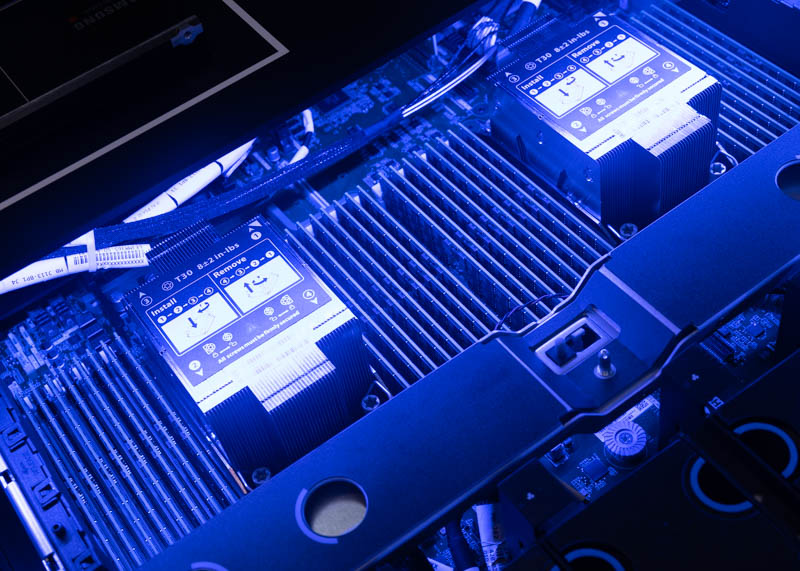
This is fairly standard practice for Samsung to show off unreleased platforms, as it showed off an Intel Sapphire Rapids Xeon platform in 2021 at OCP Summit 2022.
For those wondering about the photos, these were taken with a Canon R5 at ISO 12800 because the Samsung booth had very challenging lighting.
Final Words
Overall, the new Samsung PB SSD is interesting. A ZNS 128TB QLC SSD is certainly one of the more unique offerings, but it is also not the first time we have heard Samsung or others discuss storage at this scale. A ZNS SSD gets higher capacity utilization from its NAND than a conventional SSD, so it is slightly larger in total capacity than its 100TB-class predecessors. While large capacities make headlines, one of the biggest challenges to devices like this SSD is the failure domain. 100TB+ per device means that a storage cluster would need to rebuild a lot of data in the event of a failure adding to more storage traffic, drive access, and CPU utilization during the healing process. Many organizations are not ready to put drives this large into production.

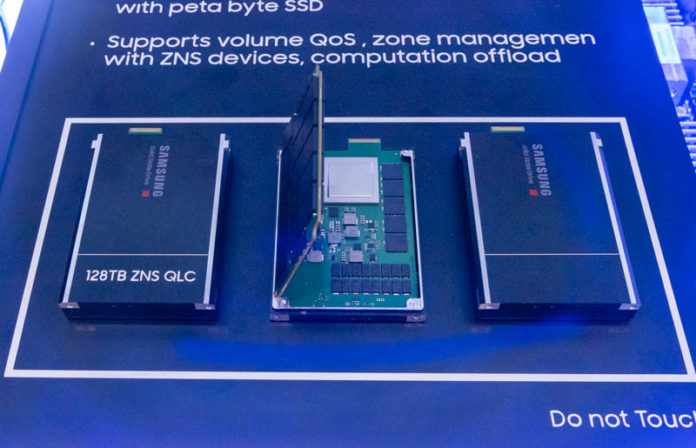


will be great for countries where electric power is expensive, or where you can not upgrade power and cooling cheap and easy
60*1024TB = 61440TB total
61440TB / 128TB = 480 drives.
From that picture, it looks like 10x 2U systems.
So each system has 48 drives in it?
Any idea what these are going to cost? (per-TB or per-TB or per-disk, whatever)
I think PB was Samsung referring to its flash storage capacity of 1 PetaBit
@Thnk2 Technology
In the 2nd picture here Samsung PR writes:
” Increases rack-scale space efficiency with peta byte SSD “
@Jay Kastner yup, racks have been known to hold more than 8 SSDs lol
James> “So each system has 48 drives in it?”
Ideally, more than 48, ie 60 per for a RAID5 with 60PB and 20% parity drives.
And yes that is doable.
Samsung have been pushing their KV-SSD concept a while back, a bunch of research was made, an interface was standardized two years ago, and yet, still can’t get any production ready SSD’s with a NVMe-KV command set. Have they just abandoned it?
As I understood, Samsung want to make new concept server called as PB-SSD that is consisted with over 24 ZNS SSDs. They want user (host) use it as SSD so that they provide some management S/W inside the storage box.
18 months later and these are nowhere to be found … Samsung just announced products that don’t actually exist.